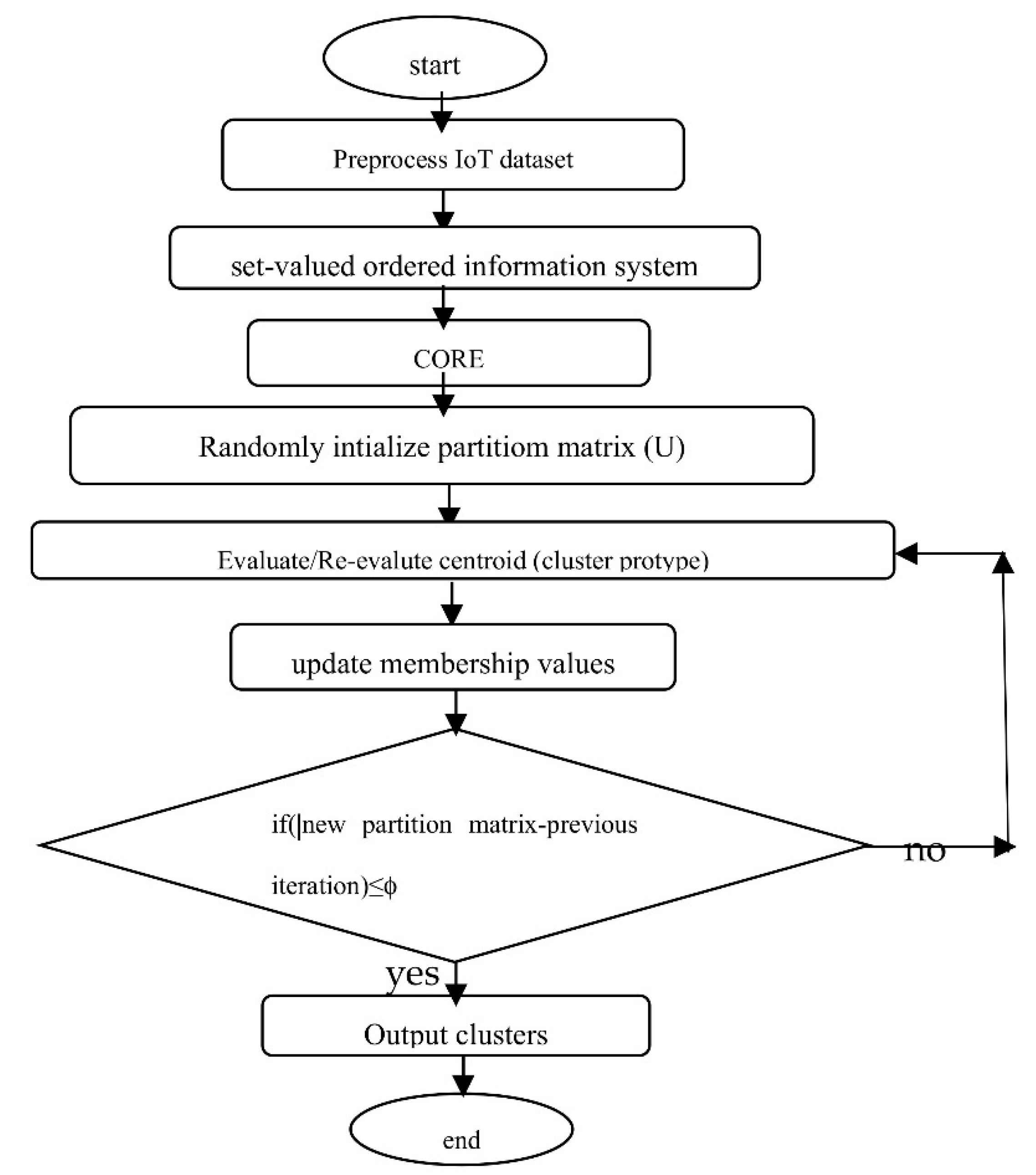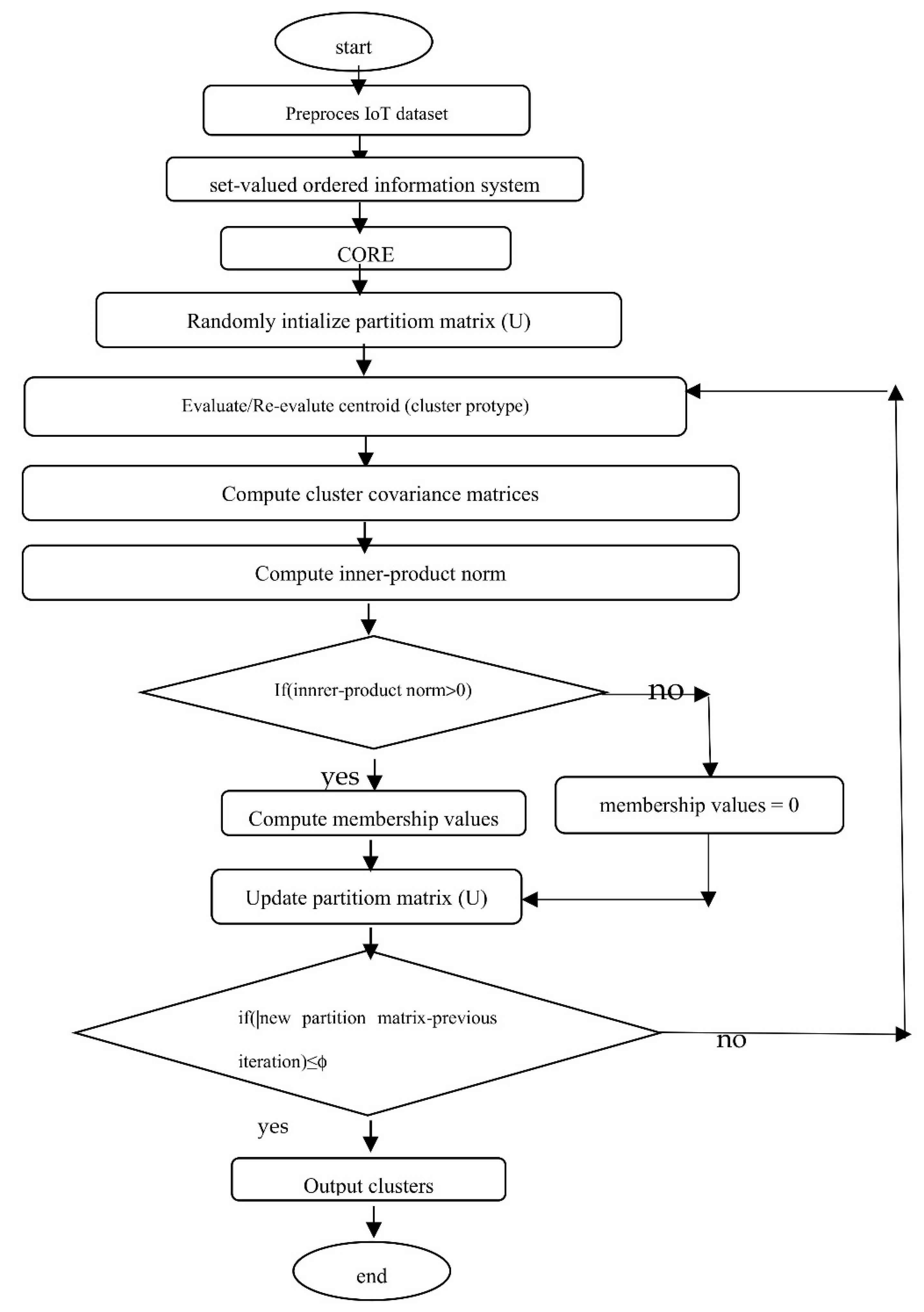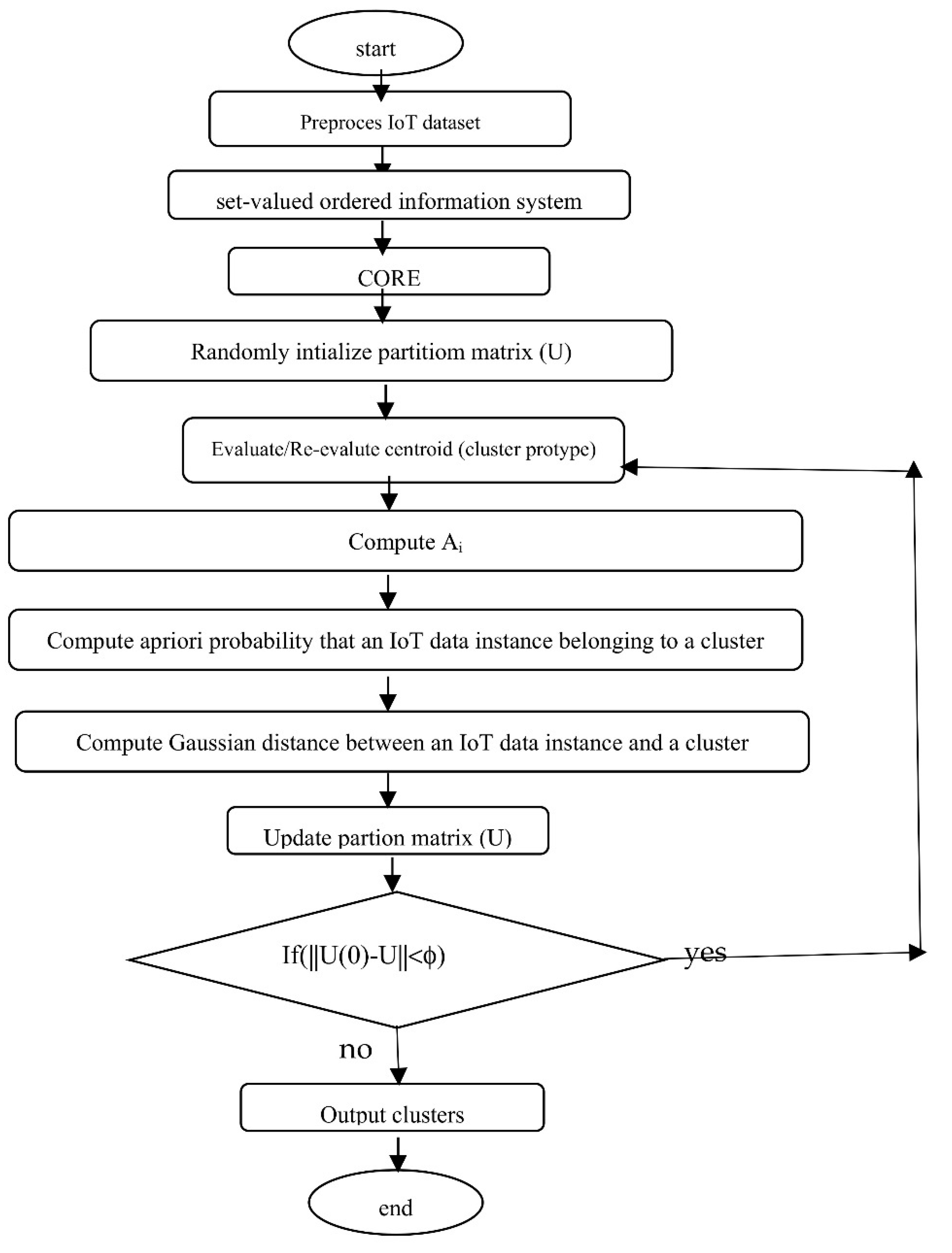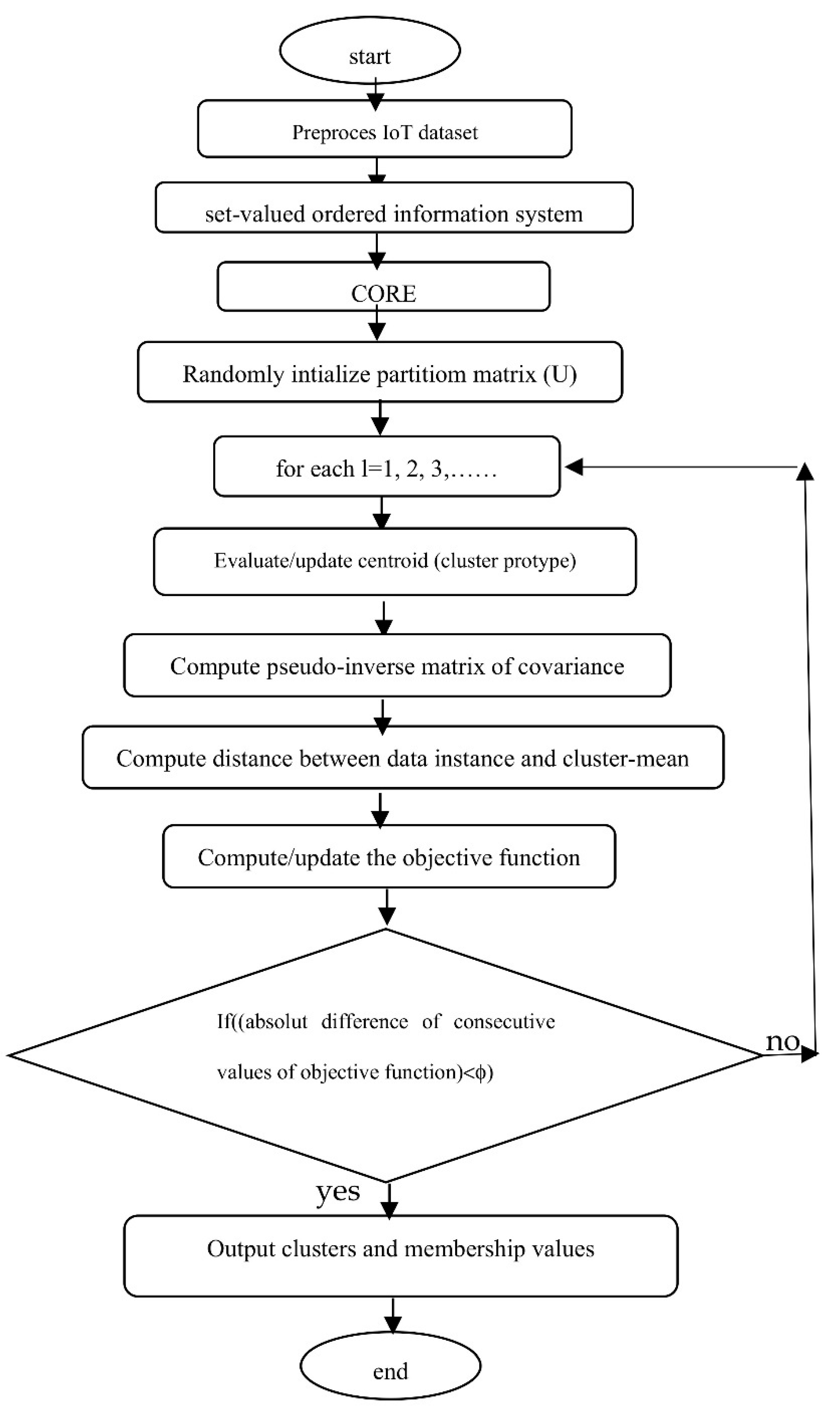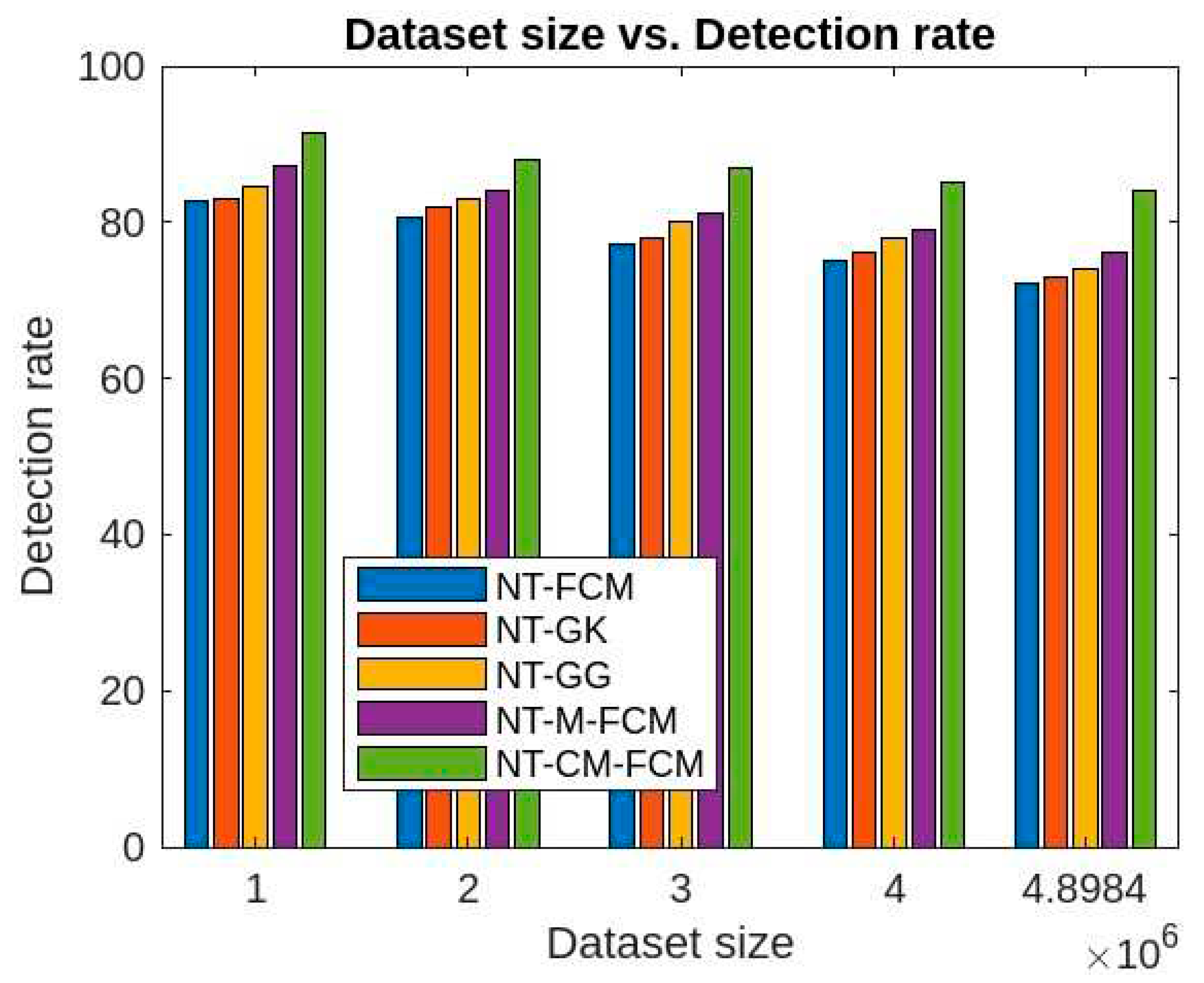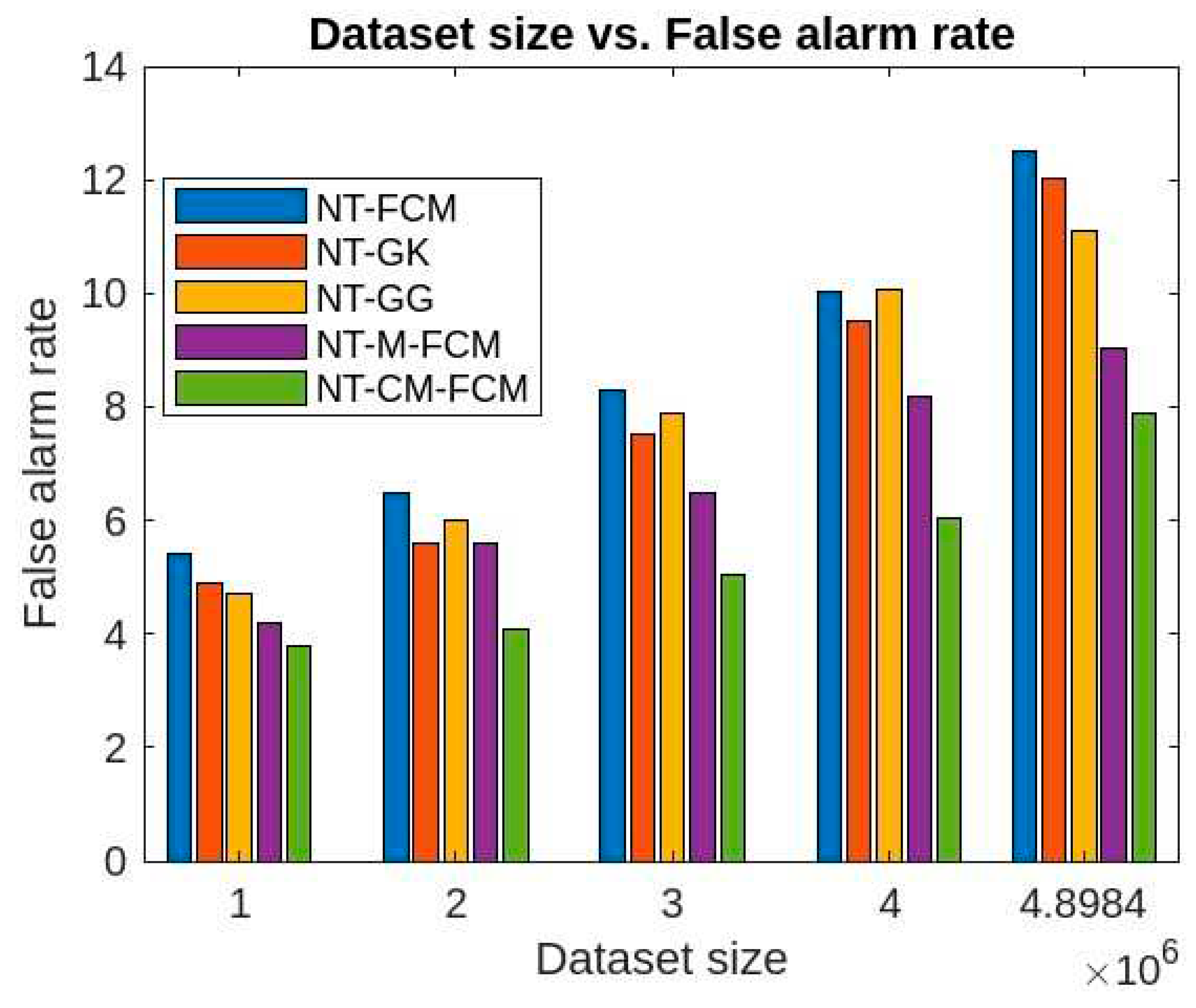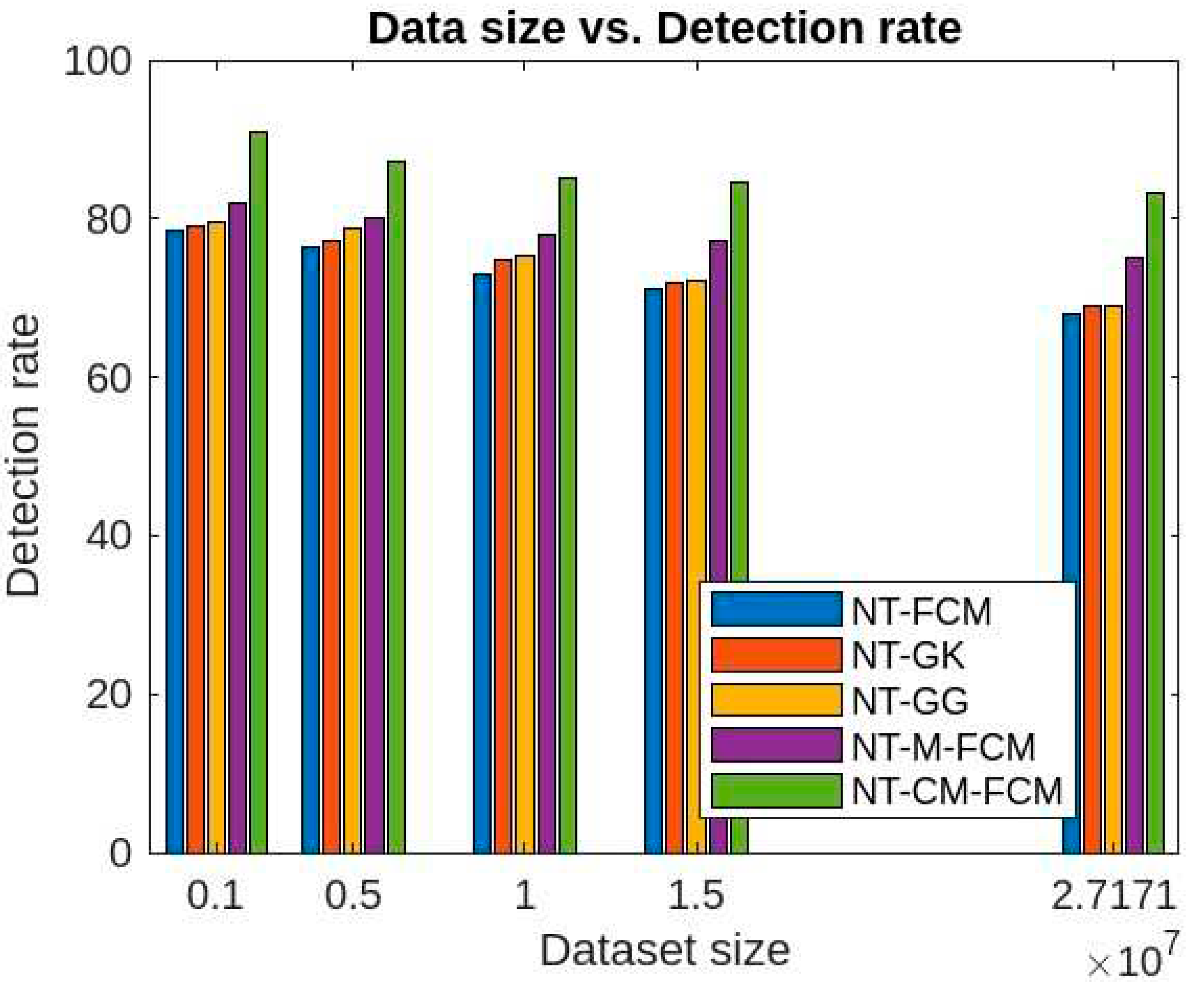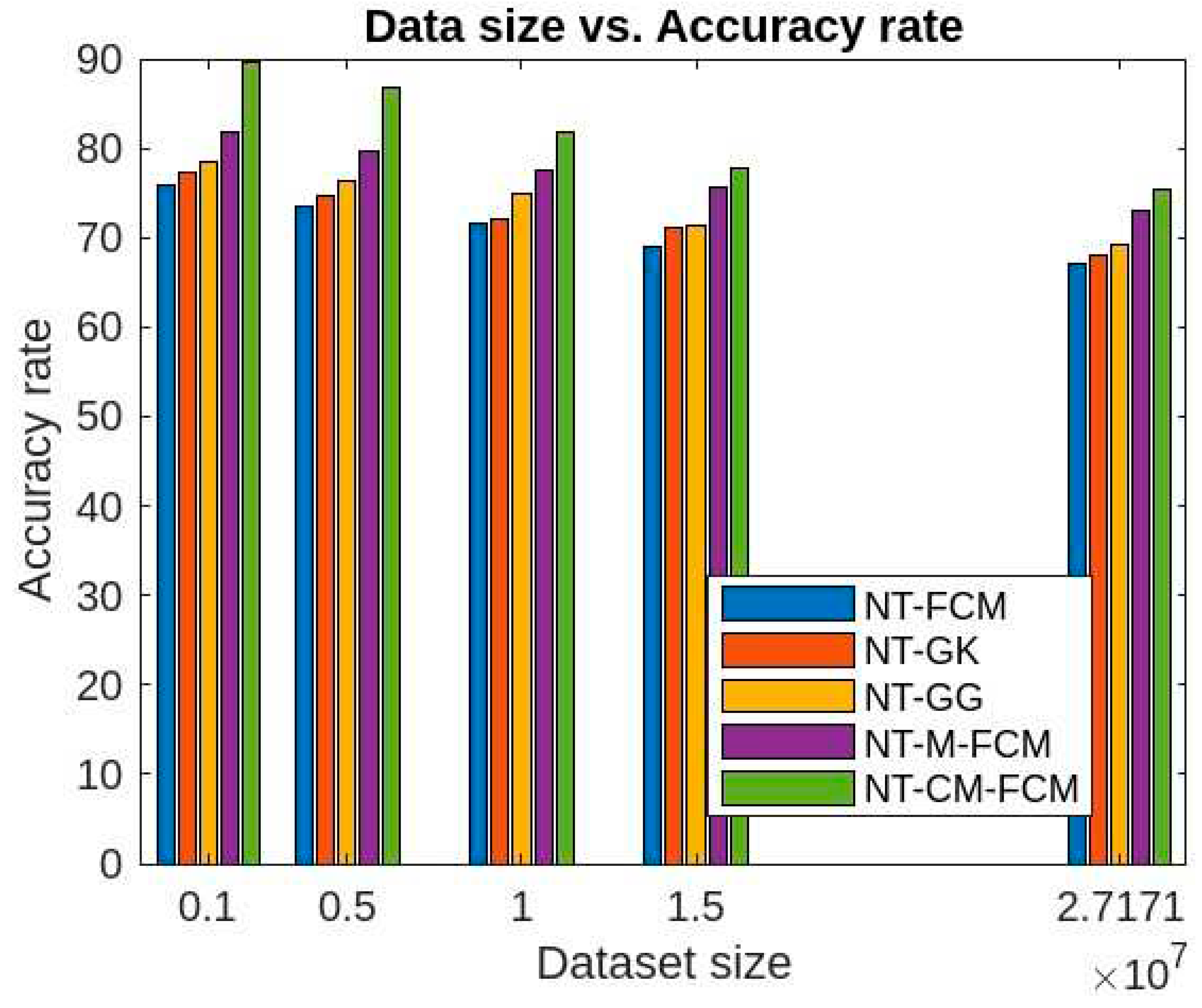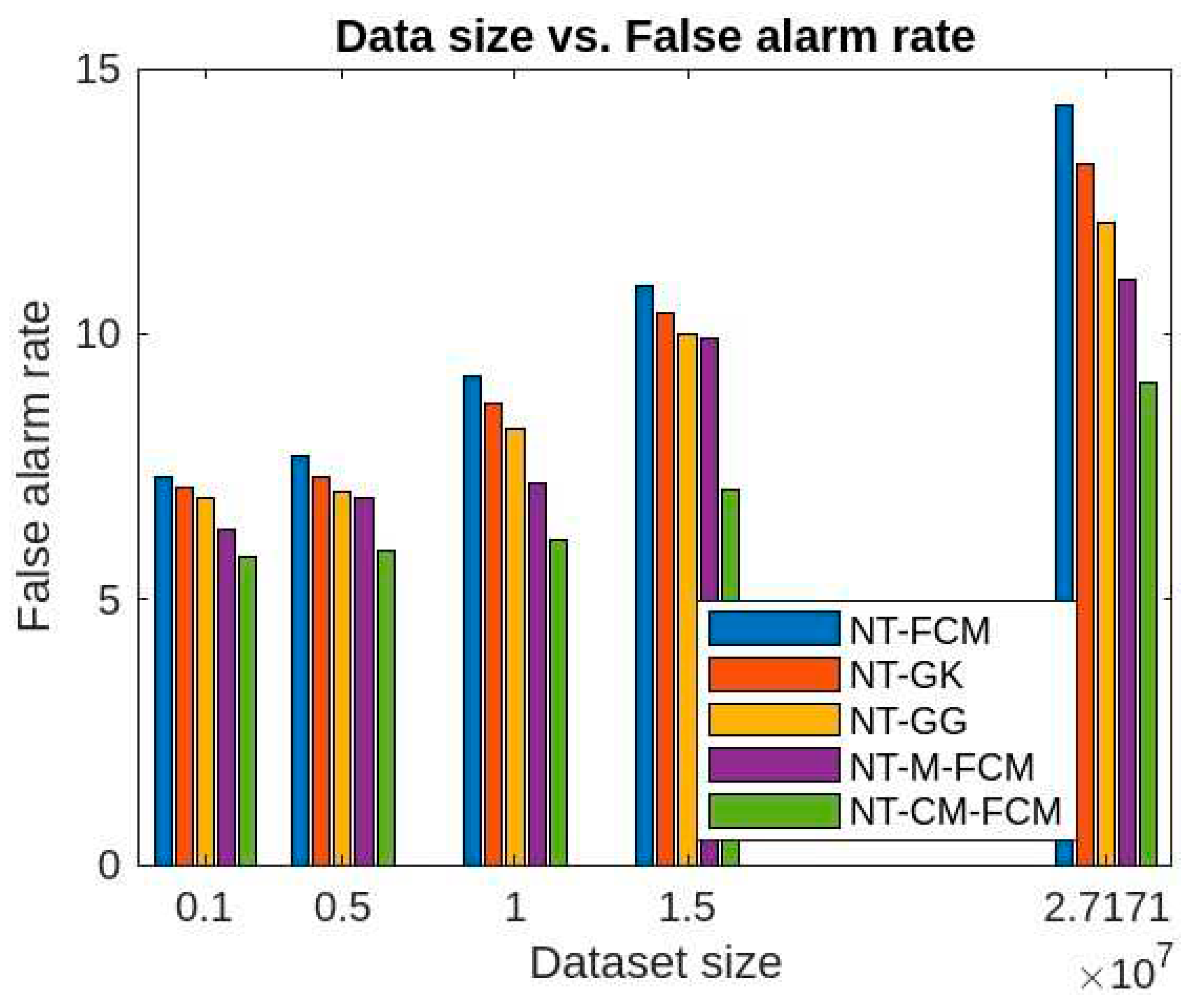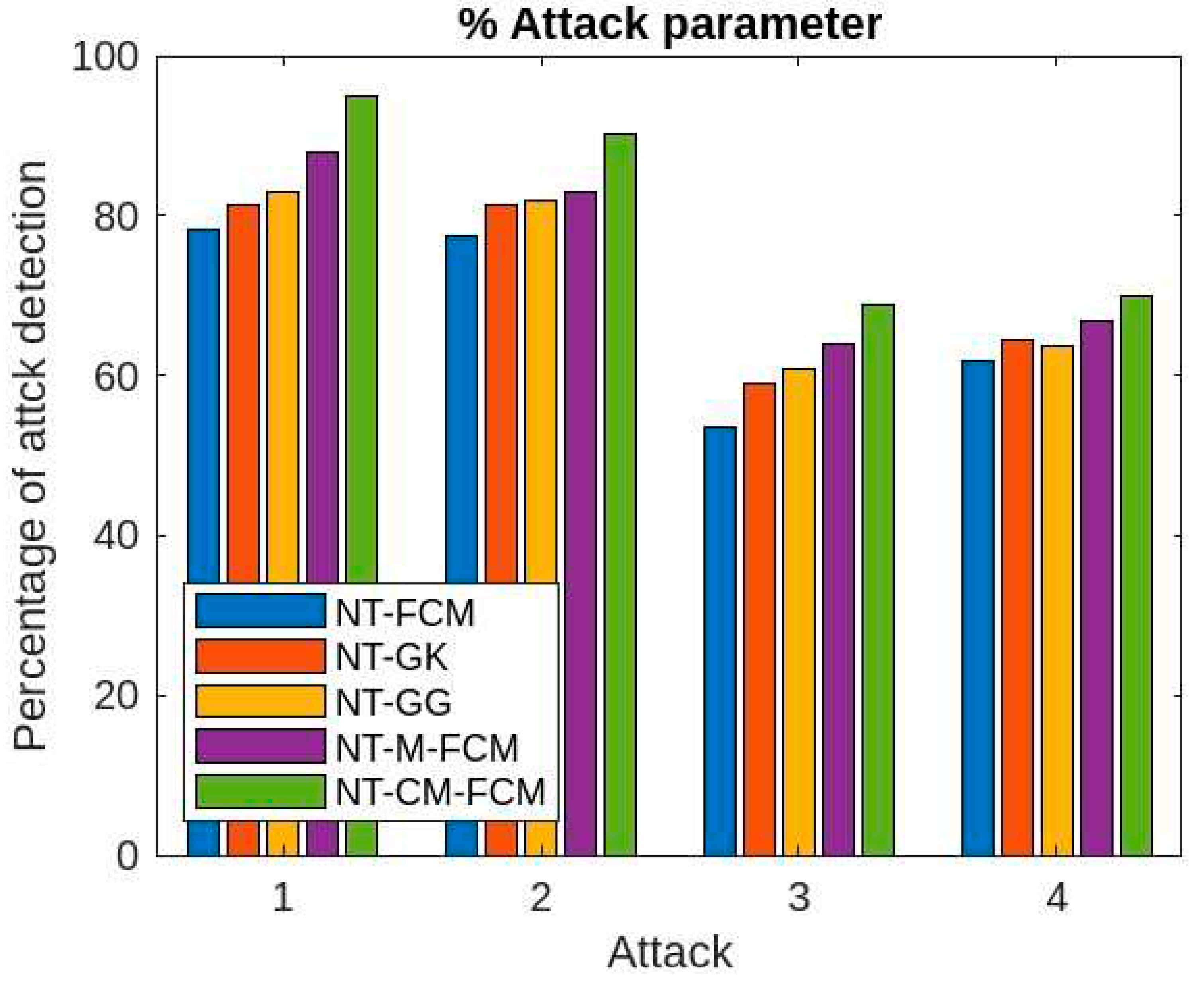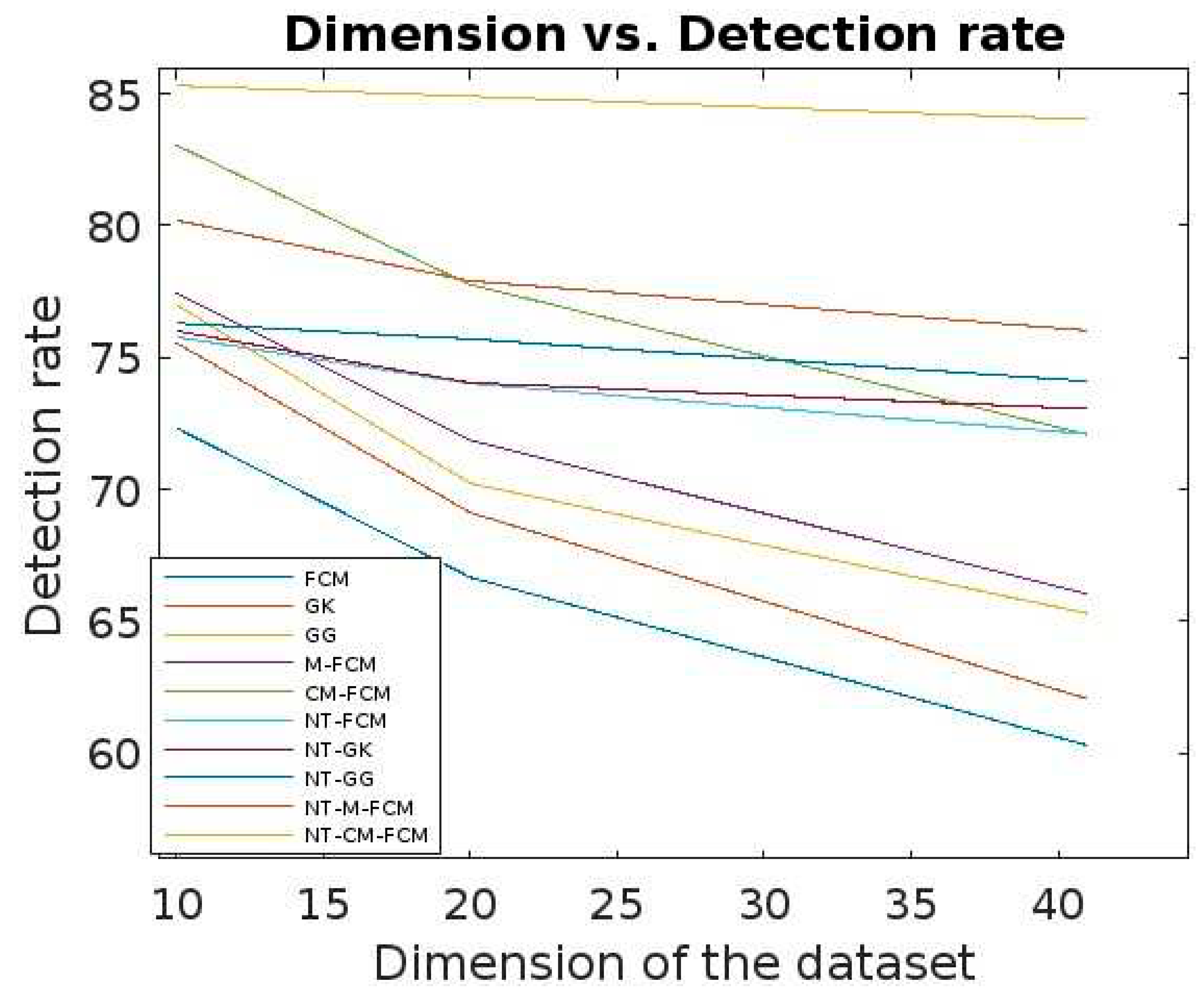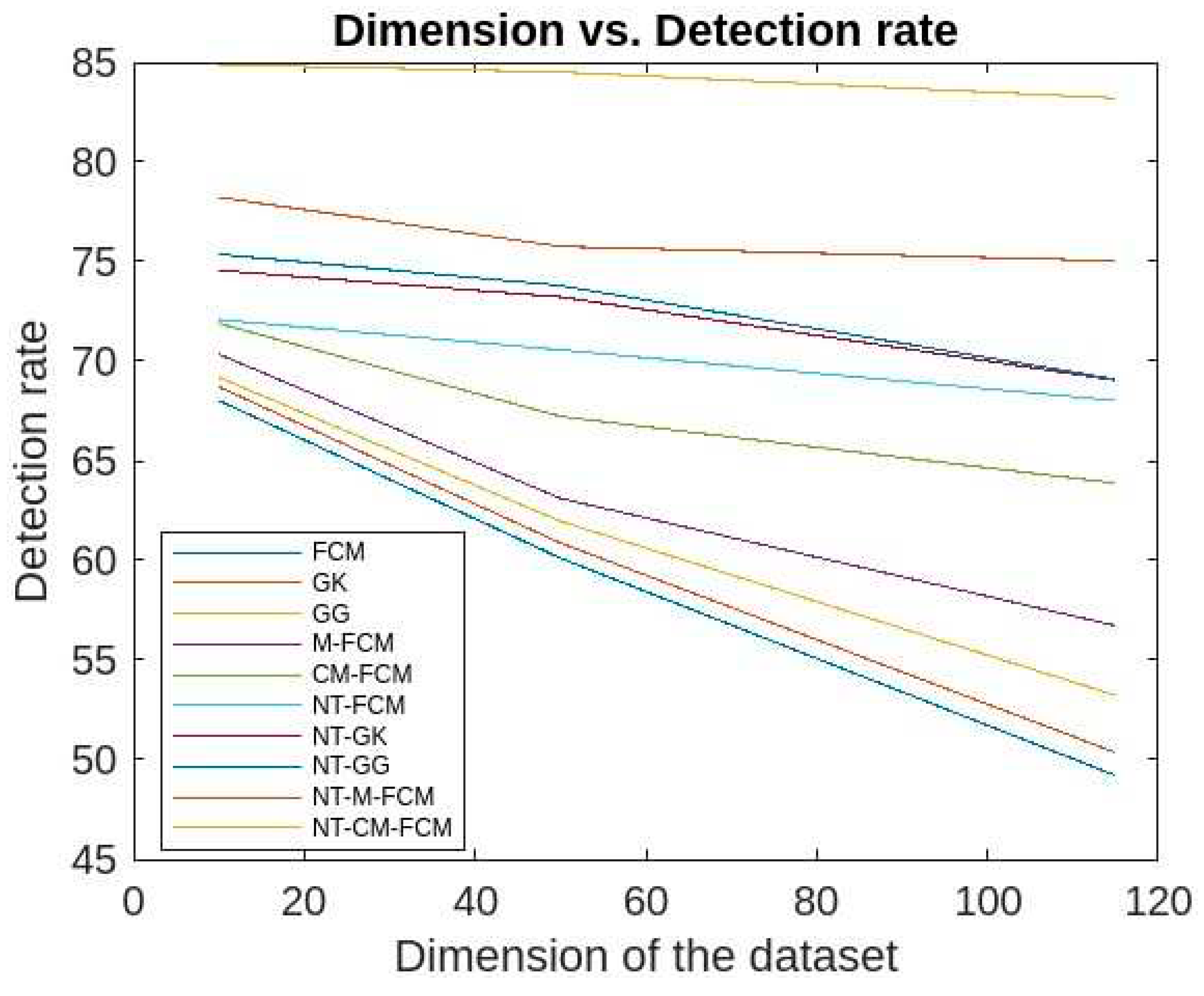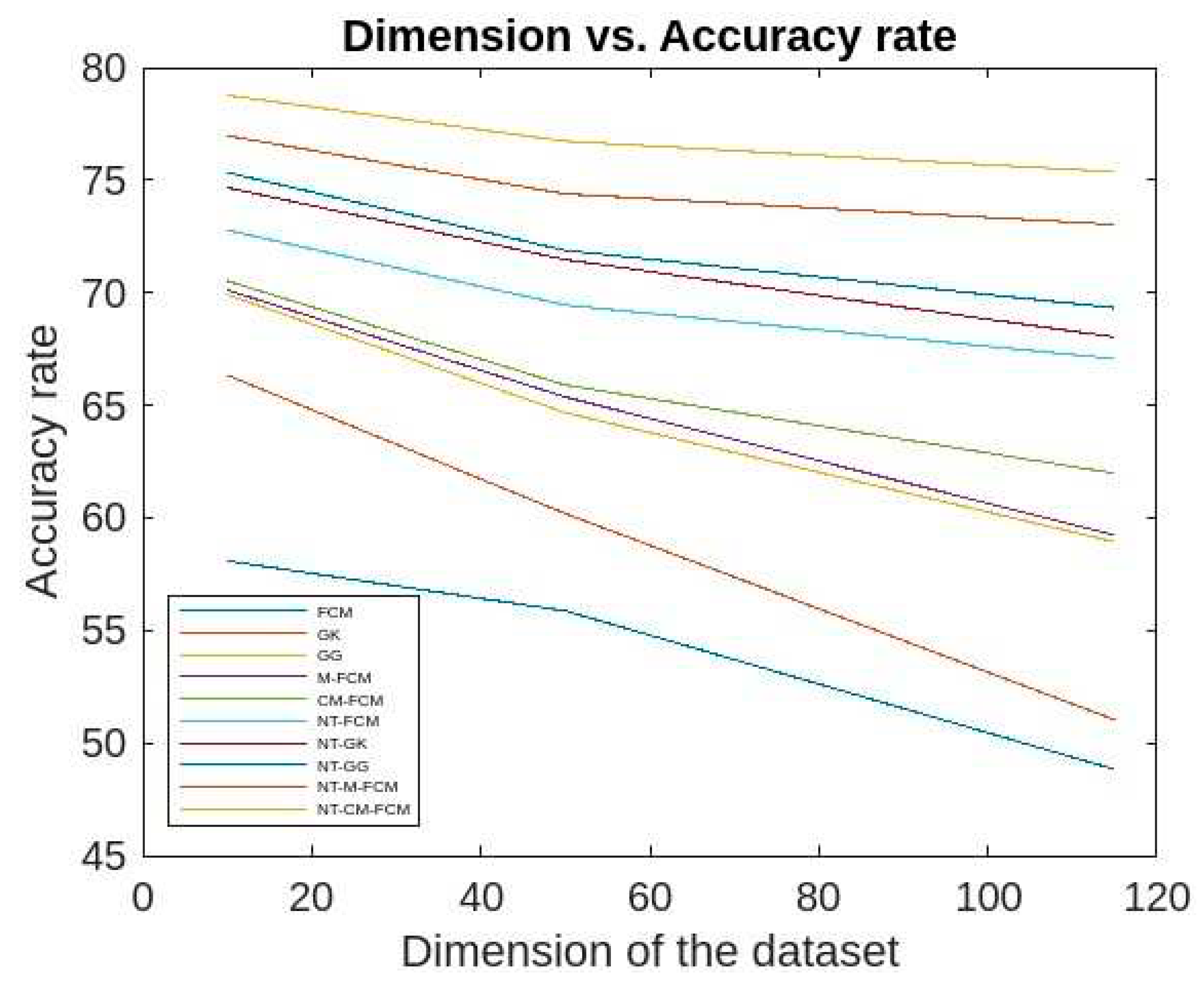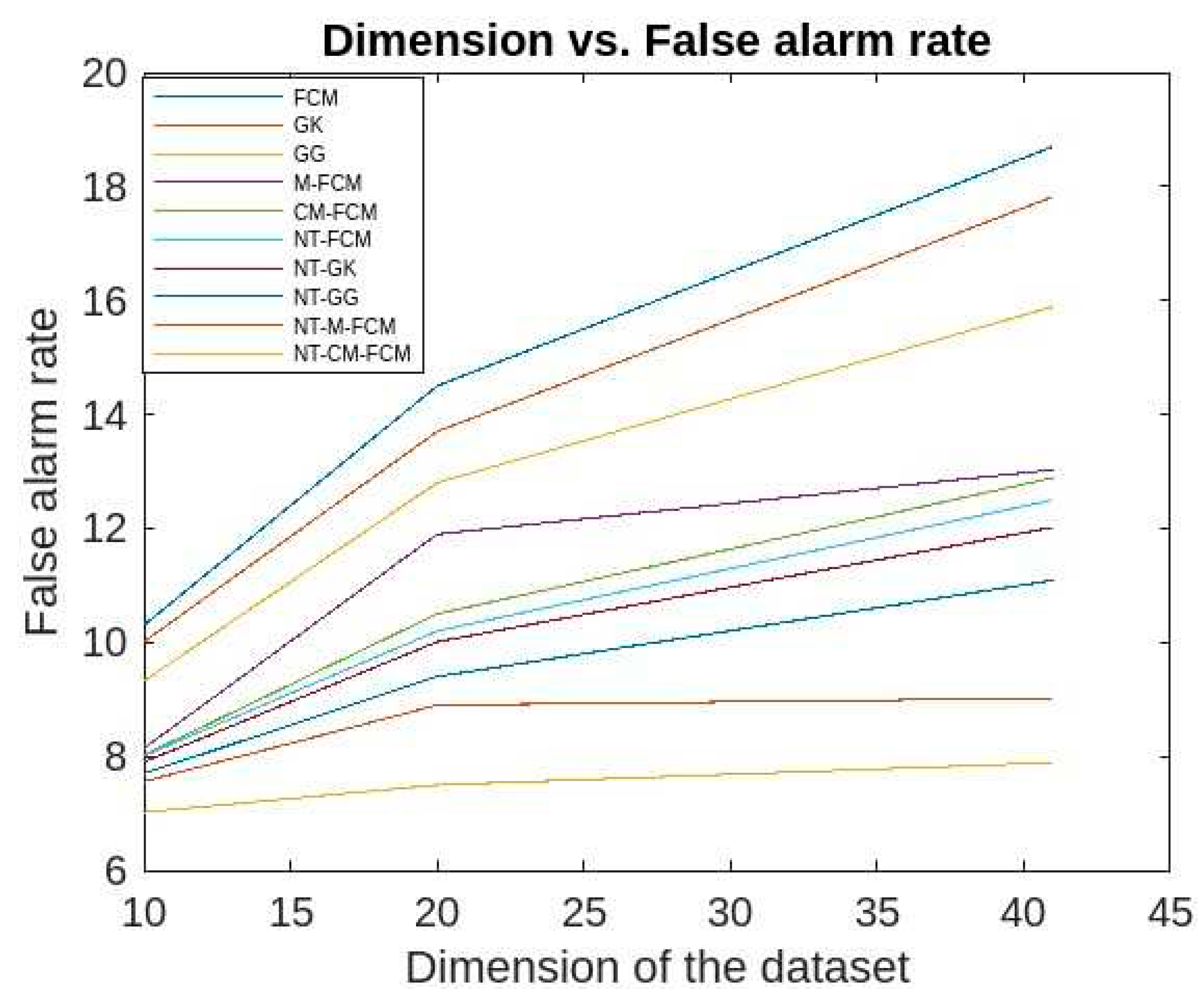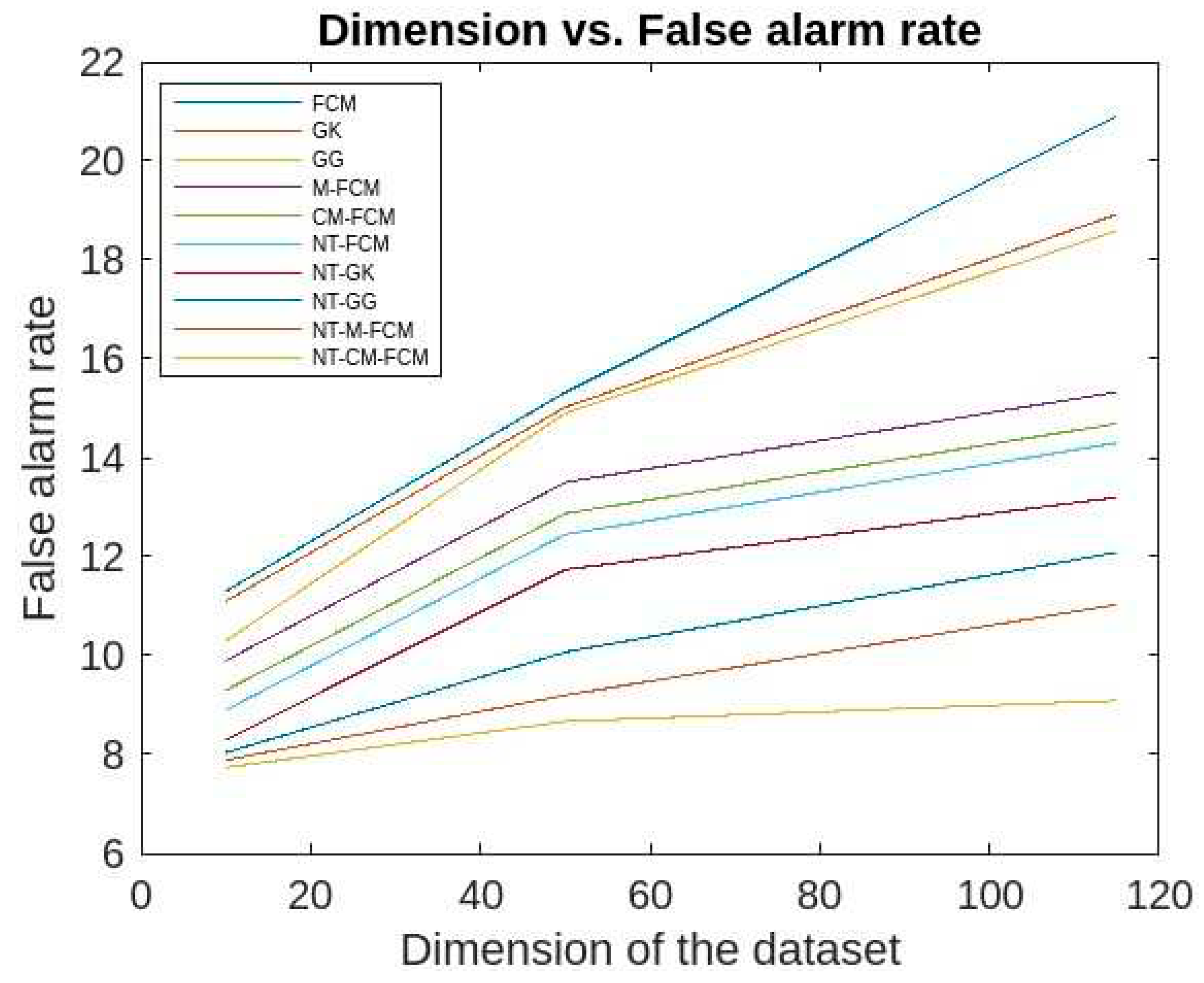1. Introduction
There is a huge applications comprising sensors that provide critical data that evolves over time, mostly as a result of the development of the IoT [
1] along with their sources of real data generation. As a result, we are witnessing a rapid surge of streaming and time-series data availability. Analysing such data can yield insightful information.
The uncovering of anomaly from IoT data has substantial real-world applications across various activities such as pre-emptive maintenance, prevention of fraud, fault finding, and monitoring. Therefore, detecting anomalies can provide actionable information in the circumstances, where no trustworthy answers exist. Reliable answers to the problems are put forwarded to address the IoT anomaly.
High dimensionality typically makes it difficult to discover anomalies. Data sparsity is a result of the fact that as the features or attributes grows, more data is necessary to generalization of the detection system. These extra variables or a significant quantity of noise from numerous insignificant features, which hide the genuine outliers, are the cause of the data sparsity. The "curse of dimensionality" [
3,
4] is a famous term coined for the problem. Therefore, several conventional anomaly detection techniques like
k-means,
k-medoids, DBSCAN [
5,
6,
7] are found to be unsuitable for such data as they fail to retain their efficacy.
In [
8], the authors introduced a new concept called rough set theory, for dealing with uncertainty or vagueness existed in any real life problem. In [
9], a classification algorithm based on neighbourhood rough set was proposed for the anomaly detection in mixed attribute datasets. In [
10], the authors defined nano topological space of a subset
X of universe
U using both the approximations of
X. In [
11], the authors have proposed to generate CORE (a subset of attribute set) of conditional attribute set for medical diagnosis.
Clustering is a data mining technique used to unearth the distribution of data and the patterns in any datsets. Clustering has been widely applied in anomaly detection. In [
12], the authors used
k-means algorithm for anomaly detection approach in network traffic dataset. A fuzzy
c-means clustering-based technique for anomaly detection in mixed data has been put out by the authors in [
13]. In [
14], the authors put forwarded a hierarchical clustering method for mixed data anomaly detection. For detecting anomalies in mixed data, in [
15], a hybrid clustering strategy is proposed that combines both partitioning and hierarchical techniques. In [
16], an method of finding of anomaly in high-dimensional and categorical data was proposed. Analogous researches were presented in [
17,
18,
19,
20,
21,
22,
23,
24,
25,
26,
27,
28,
29]. The authors of [
30] addressed the insider threat, which poses serious problems for the industrial control systems' cyber security. The authors of [
31] presented an online random forest-based anomaly detection method. In [
32,
33,
34], fuzzy techniques for real-time anomaly detections were covered. For the purpose of identifying anomay in significant cyberattacks, the authors of [
35] presented a fuzzy approach based on neural networks.
The majority of the aforementioned algorithms have some limitations. Some, for instance, are ineffective at finding anomalies in high-dimensional data. In [
36], the authors put forwarded a mixed algorithm consisting of a partitioning and a hierarchical approach for real-time anomaly detection which produces stable clusters along their fuzzy lifetimes. However, the algorithm [
36], is not so efficient in high-dimensional data. Also traditional
k-means algorithm has wide range applications, it is not free from difficulties such as difficulties in determining the number of clusters, sensitivity to initial cluster centres, low accuracy rate etc. Some of the aforesaid issues were addressed nicely in [
15,
36,
37,
38,
39,
40]. But there is still room for improvement.
Anomaly detection models based on fuzzy
c-means algorithm [
32,
41,
42,
43,
44,
45,
46,
47] can be a better solution for the aforsaid issues for three primary reasons. Firstly, fuzzy clustering allows for overlapping clusters useful in dealing with complex structure or ambiguity or overlapping class boundaries available in datasets. Secondly, they are more robust to anomalies and noise, as transition from one cluster to another is gradual. Thirdly, because it enables a more thorough depiction of the relationship between data points and clusters, fuzzy clustering offers a more nuanced view of the data's structure. In [
48], the authors proposed a new algorithm MSRFCM (Mahalanobis Shadowed Rough Fuzzy Clustering Method) which uses Mahalanobis distance to improve the accuracy of intrusion detection. Using principal component analysis for selecting most discriminative features a fuzzy
c-means clustering approach was presented in [
41] for intrusion detection in network data. In any IoT applications the data are high-dimensional. Also computation of high-dimensional correlation matrices for Mahalanobis distance is almost impossible, so it doesnot work good for high-dimensional data
In this article, most of the shortcomings of aforesaid methods are addressed in an efficient manner and an hybrid aapproach is proposed which uses nano topology and a couple of fuzzy clustering algorithms for detecting anomalies in high dimensional IoT data.
The the paper's objective is described as follows:
A nano topology [
10,
49] along with its basis is constructed to identify a subspace using Nano Topology-based Subspace Generation Algorithm.
Secondly, a couple of well-known fuzzy clustering approaches is proposed to generate soft clusters.
A comparative analysis is conducted among all the proposed fuzzy clustering based approach along with the traditional approaches.
The method initially finds a smaller dimensional space by deleting unnecessary features using a rough set theoretical approach. Then, fuzzy clustering-based approach namely fuzzy
c-means algorithm (FCM) [
41,
47], Gustafson-Kessel Algorithm (GK) [
42,
43,
44,
45,
46,
47], Gath-Geva Algorithm (GG) [
43,
47], Mahalanobis Distance based Fuzzy
c-Means algorithm (M-FCM) [
47]
, and Common Mahalanobis Distance based Fuzzy
c-Means algorithm (CM-FCM) [
47] are used to the afore-mentioned subspace in order to identify the fuzzy clusters. The approaches time-complexities are also calculated. The suggested approaches are then tested with the help of MATLAB and the datasets KDDCup’99 [
50] and Kitsune Network Attack Dataset [
51], and comparisons are also made. The results convincingly show that nano topology based CM-FCM (NT- CM - FCM) is more effective than others.
The paper is prescribed in the following manner. The problem statement is presented in
Section 2. The proposed methods are discussed in
Section 3. The complexity analysis of the methods is presented in
Section 4. The experimental results and discussions are presented in
Section 5, and the paper's conclusions, limitations, and recommendations for further research are presented in
Section 6.
3. Proposed Methods
The method proposed in this article is a two-staged hybrid approach consisting of subspace generation and fuzzy clustering. In stage 1, rough set-based approach is used to generate subspace. In stage 2, fuzzy clustering methods are employed to generate fuzzy clusters. The stage 1 of the proposed method is described as follows. Our dataset S=(U, A) is an information system consisting of both conditional and decision attributes. First of all, a data pre-processing techniques is applied to convert it to set-valued ordered information system. Then, a dominance relation, a nano topology and its basis are generated. Then the criterion reduction process is used to generate CORE(A) as a subset of A. This way new information system E=(U, CORE(A)) ⊆ S is computed. The pseudocode of the algorithm for the criterion reduction is given below.
Algorithm 1: Nano Topology-based Subspace Generation
Input. (U, A): the information system, where the attribute set A is divided into C-conditional attributes and D-decision attributes, consisting of n data instances,
Output: Subspace of (U, A)
Step1. Generate a dominance relation on U corresponding to C and X⊆U.
Step2. Generate the nano topology and its basis
Step3. for each x∈C, find and
Step4. if ()
Step5. then drop x from C,
Step6. else form criterion reduction
Step7. end for
Step8. generate CORE(C)=∩{criterion reductions}
Step9. Generate subspace of the given information system.
The above algorithm supplies the CORE of the attribute set by removing insignificant attributes which gives us a subspace E=(U, CORE(A)) of the given information system S=(U, A). Since, the nano topology is generated for the generation of CORE. We term the above algorithm as nano topology-based subspace generation algorithm. Then stage 2 of the method starts. For stage 2, we have explored different variations of fuzzy clustering algorithms. The algorithms are described as follows.
Fuzzy C-Means (FCM) Algorithm [41]
A large class of FCM algorithms is based on the minimization of fuzzy
c-Means functional formulated as follows.
where
U=[
μik]∈
Ffc (fuzzy partition of
X) and
V=[
v1,
v2,…
vc],
vi∈
Rn, a vector of cluster’s mean which need to be computed.
is squared inner-product norm and m∈ [1, ∝], decides the resulting cluster’s fuzziness. The equation (8) measures the total variance of xk from vi.
The minimization of (8) is a non-linear optimization problem and can be solved by various methods like Picard’s iteration method. The first order conditions of stationary points through Picard’s iteration method is known as Fuzzy
c-Means Algorithm (FCM) [
41].
The stationary points of (8) can be obtained by adjoining constraints to
J with Lagrange’s multipliers [
41].
By setting the partial derivatives of J with respect
U,
V and
λ to 0. If
∀
i,
k and
m>1, then (
U,
V)∈
Ffc ×
Rc×n will minimize only if
The above solutions (10) and (11) also satisfy (7) are the first order necessary conditions for the existence of stationary points of the objective function (8).
Algorithm 2: (FCM)
Given dataset X, choose the number of cluster c ,(1<c<N), weighting exponent m> 1, terminating thresholdφ> 0, and A (norm-inducing matrix).
Initialize U=U(0) // U(0)∈Ffc
for each j =1, 2,…..
step1 compute cluster mean , i=1, 2,..c
step2 compute , i=1, 2,..c, k=1, 2,…N
step3 for k=1, 2,..N // update partition matrix
if DikA> 0, for all i=1, 2,…c
,
else = 0 if DikA> 0, with =1
until||U(j)-U(j-1)||<φ
Definition 2.11 [48]
Eucidean distance though used many times in clustering-based anomaly detection algorithm, has limitaions. Euclidean diastance measures the shortest distance between two points. Euclidean distance doesnot take into consideration the correlation between the attribute values, so Euclidean distance assigns equal weight to such variables which essentially measure the same feature. Therefore this single feature gets extra weight. Consequently,correlated variables gets excess weight by Euclidean distance which effects the accuracy. Since the IoT data are highly correlatedS, it is preferable to use Mahalanobis distance rather as it takes into account the correlation between the variables. It is a scale-invariant metric which gives distance between a point
x∈
Rn generated from a given
p-variant probability distribution P
X(.) and the distribution’s mean
μ=
E(
X). Suppose P
X(.) has finite second order moments and ∑=
E(
X-
μ), the covariance matrix, then the Mahalanobis distance [
43,
44,
47] is given by
If the covariance matrix is identity matrix, the Mahalanobis distance reduces to Eucidean distance.
Gustafson-Kessel (GK) Algorithm [42,47]
This is an extension of FCM where an adaptive distance norm was used to detect clusters of various shapes from one dataset. Each cluster has its own norm-inducing matrix
Ai, which produces the inner-product norm given below.
The matrices
Ai are used as optimization variables in the
c-Means functional, which allow each cluster adapt the distance norm to the local topological structure of the data. The objective function of GK algorithm is given by
where
Ai = |Σ
i|
1/p Σ
i-1
The GK algorithm for fuzzy clustering is given below.
Algorithm 3: (GK)
Given dataset X, choose the number of cluster c ,(1<c<N), weighting exponent m> 1, terminating thresholdφ> 0, and cluster volume M.
Initialize U=U(0) // U(0)∈Ffc
for each j =1, 2,…..
step1 compute cluster mean , i=1, 2,..c
step2 compute the cluster covariance matrices
, i=1, 2,..c
step3 compute (fori=1, 2,..c, k=1, 2,…N) using equation (13) and (15)
step4 for k=1, 2,..N // update partition matrix
if DikA> 0, for all i=1, 2,…c
,
else = 0 if DikA> 0, with =1
until||U(j)-U(j-1)||<φ
Gath-Geva Algorithm (GG) [43,47]
Gath and Geva
[43,47] proposed an extension of GK algorithm by introducing maximum likelihood estimates instead of Euclidean distance which can be used to detect clusters of varying shapes, sizes, and densities. The objective function of the algorithm is given by
where
is the Gauss distance between
xk and cluster mean
vi and is given by
Also
αi is the a-priori probability of
xk belonging
ith cluster and is given by
The objective function (16) is minimized by the following equations
As the algorithm uses exponential distance norm, it requires a good initialization.
Algorithm 4: (GG)
Given dataset X, choose the number of cluster c ,(1< c< N), and terminating thresholdφ> 0.
Initialize U=U(0) // U(0)∈Ffc
step1 compute cluster mean vi
step2 calculate the distance measure using equation (17)
step3 calculate Ai
step3 calculate the value of the membership data function using equation (20) and update U, the partition matrix
until||U(j)-U(j-1)||<φ.
Mahalanobis Distance based Fuzzy C-Means algorithm (M-FCM) [47]
The objective function of M-FCM algorithm is given by
such that
m∈[1, ∝],
U=[μ
ik]
c×n, μ
ik∈[0, 1],
i=1, 2,…
c;
k=1, 2,…
n,
Minimizing (22) with respect of all its parameters subject to the constraints (23) and (24) yields the M-FCM algorithm.
Algoritm 5: (M-FCM)
Given dataset X, choose the number of cluster c ,(2 <c <N), weighting exponent m ∈ [0, ∝), iteration stop threshold φ > 0.
Initialize randomly partition matrix (membership matrix) U subject to the constraint (23), iteration counter l=1.
Step1 Evaluate or update cluster-centroid vi; i=1, 2,…c.
Step2 Evaluate pseudo-inverse matrix of covariance
Step3 Evaluate using (24)
Step4 Evaluate the value of the objective function (J) using (20)
Step5 Set l=l+1 to update objective function J
Step6 If the value of the objective function obtained in step3 satisfies , stop
Output cluster set and membership matrix
Step7 Else go to step1
Common Mahalanobis Distance based Fuzzy C-Means algorithm (CM-FCM) [47]
In this algorithm all the covariance matrices (
of the objective function of are replaced with a common covariance matrix (
). The objective function of CM-FCM is given as follows
Subject to the constraints
m∈[1, ∝],
U=[μ
ik]
c×n, μ
ik∈[0, 1],
i=1, 2,…
c;
k=1, 2,…
n,
Minimizing the objective function (25) with respect to its parameters subject to the constraints (26) and (27) gives the CM-FCM algorithm.
Algorithm 6: (CM-FCM)
Given dataset X, choose the number of cluster c ,(2<c<N), weighting exponent m∈ [0,∝), iteration stop thresholdφ> 0.
Initialize randomly partition matrix (membership matrix) U subject to the constraint (26), iteration counter l=1.
step1 Evaluate or update cluster-centroid vi; i=1, 2,…c.
step2 Evaluate pseudo-inverse matrix of covariance
Step3 Evaluate using (27)
step3 Evaluate the value of the objective function (J) using (25)
step4 Set l=l+1 to update objective function J
Step5 If the value of the objective function obtained in step3 satisfies , stop
Output cluster set and membership matrix
Step6 Else go to step1
It is to be mentioned here that when the covariance matrices become identity matrices CM-FCM becomes FCM. Thus, FCM is a special case of CM-FCM algorithm.
Here each cluster in the final output cluster set is a fuzzy set consisting of IoT data instances along with their membership grades. The IoT data instances which belong to all fuzzy clusters with minimum membership values would be treated as anomalies. A flowchart of the Nano topology-based fuzzy
c-means clustering algorithm is given in
Figure 1 below.
A flowchart of the Nano topology-based GK clustering algorithm is given in
Figure 2 below.
A flowchart of the Nano topology-based GG clustering algorithm is given in
Figure 3 below.
A flowchart of the Nano topology and Mahalanobis Distance based Fuzzy C-Means algorithm (NT-M-FCM) is given in
Figure 4 below.
A flowchart of the Nano topology and Common Mahalanobis Distance based Fuzzy C-Means algorithm (NT-CM-FCM) is given in
Figure 4 below.
The approaches employed here consist of various combinations of the algorithms of the form (Algorithm1 + Algorithm2), (Algorithm1 + Algorithm3), (Algorithm1 + Algorithm4), (Algorithm1 + Algorithm5), and (Algorithm1 + Algorithm6), where Algorthm1 (common to all) used for dimension reduction and others are used clustering. The approaches are well-described using flowcharts from
Figure 1,
Figure 2,
Figure 3,
Figure 4 and
Figure 5. The methods supply specified number of fuzzy clusters in the lower-dimensional space. The anomalous items are those IoT data instances which either do not belong or belong to clusters with minimum membership values.
4. Complexity Analysis
If |U|=m, and |C|=n, the worst-case time-complexity algorithm1 is O(m2.n). Since, FCM uses the norm inducing matrix, the time-complexity of distance function of fuzzy clusters is O(c.(c-1).d/2) = O(c2.d). The worst-case complexity of FCM is O(m.c2..d.i) = O(m.n.m2.i) = O(m3.n.i), where d (≤ n) is the dimension of the subspace generated by Algorithm 1, c (≤ m) is the number of fuzzy clusters and I is the number of iterations. The overall time-complexity of NT-FCM is O(m2.n + m3.d.i). Obviously, i ≤ m, and d≤n being small can be nexlected, therefore the overall worst-case time complexity of NT-FCM is O(m2.n + m4), which shows that it is linear with respect to the dimension of the dataset. In general, n ≤ m, which gives worst-case complexity as O(m4).
In finding the compuational complexity of NT-GK Clustering algorithm, the complexity of NT is same as O(m2.n). For finding new cluster, and fuzzy c-means membership, the algorithm needs O(c), and O(n.c), which are same as FCM. In this algorithm, the most important task is that each cluster has its own norm-inducing matrix, which produces inner product norm and the time-complexity of such for c clusters is O(k(m.d.m.d)) = O(m2.d2), where k is the constant time required for computing Ai. If i be the number of iterations, the overall time-complexity is O(m2.n + i.(c + n.c + c.m2.d2)) = O(m2.n + m2.n + m4.d2)=O(m2.n + m4.d2), where i=O(m), c=O(m) and d ≤ n ≤ m (in general) is small. Thus, the worst-case time-complexity of the algorithm is O(m4.d2).
The GG fuzzy clustering algorithm uses maximum likelyhood estimation measure which requires O(m.d). As it uses exponetial distance which introduces another level of complexity. The time complexity of NT-GG clustering algorithm is O(m2.n + c.(m.c..d2.i) = O(m2.n + m4..d2), where i=O(m), c=O(m) and d ≤ n ≤ m (in general) is small. Thus, the worst-case time-complexity of the algorithm is O(m4.d2).
The M-FCM computes separate matrices for each cluster, so the time complexity of NT-M-FCM algorithm is O(m2.n + i.(c + n.c + c.m.d2)) = O(m2.n + m3.d2), where i=O(m), c=O(m) and d ≤ n ≤ m (in general) is small. Thus, the worst-case time-complexity of the algorithm is O(m3.d2).
Since CM-FCM uses a common covaricnace matrix instead of separate covarinace matrices of different custers, the time complexity of NT-CM-FCM algorithm is O(m2.n + i.(c + n.c) + i.m.d2) = O O(m2.n + m2.d2), where i=O(m), c=O(m) and d ≤ n ≤ m (in general) is small. Thus the worst-case time-complexity of the algorithm is O(m3 + m2.d2).
5. Experimental Analysis, Results and Discussions.
For testing the efficacy of the approaches employed here, two well-known datasets namely, KDDCup’99 Network Anomaly dataset [
50] and Kitsune Network Attack dataset [
51]. The datasets are obtained from UCI machine repository. The datasets allong with their characteristics in summarized form are described in Table1 below.
The experiments were conducted on a standard machine using two datasets described in
Table 1. With KDDCup’99 [
50], two datasets, one having different sizes but fixed dimensions and, other having fixed sizes and different dimensions are constructed. Similarly, with Kitsune dataset [
51], two datasets of simlar sizes are constructed. The proposed methods namely NT-FCM, NT-GK, NT-GG, NT-M-FCM, and NT-CM-FCM are implemented using MATLAB with the aforesaid four datasets constructed from the aforesaid datasets. We also made comparative analysis of (FCM and NT-FCM), (GK and NT-GK), (GG and NT-GG), (M-FCM and NT-M-FCM), and (CM-FCN and NT-CM-FCM). Further, the performances all aforesaids methds along with FCM [
41], GK [
42], GG [
43], M-FCM [
47], and CM-FCM [
47] are studied in manifolds, like accuracies in detection rates, the percentage of anomalies obtained, percentage of false alarm rates etc. The detailed findings of the aforesaid investigations are presented both in the tabular form and graphically in
Table 2,
Table 3 and
Table 4 and graphically in
Figure 6,
Figure 7,
Figure 8,
Figure 9,
Figure 10,
Figure 11,
Figure 12,
Figure 13,
Figure 14,
Figure 15,
Figure 16,
Figure 17 and
Figure 18 below.
The following inferences can be drawn from the obtained results. From
Table 2, it is evident that that, out of all the traditional fuzzy clustering algorithm, the performannces in terms of the parameters like detection rate, accuracy rate, false alarm rate, denial of service, remote to local, user to root, and probe, of CM-FCM is quite better. However, its performance along with others reduces rapidly when a comparatively a larger dataset is considered which means that the performances depends both size and dimension of the dataset.
From
Figure 6 and
Figure 10, it can be concluded that the anomaly detection rates of all the algorithms improve if NT-based subspace clustering appraoch is considered. Though, the detection rate decreases with the increase of the size of the dataset, but the rate of decrease is much slow. Among all the NT-based approach, NT-CM-FCM is found to be comparatively as it’s anomaly detection rate ranges from 84.02% to 91.3% for the KDDCup’99 dataset and 83.21% to 90.8% for the dataset Kitsune.
As per as accuracy of anomaly detection is concern,
Figure 7 and
Figure 11 show that NT-based approach of the fuzzy clustering algorithms perform implressively in comparison to the traditional fuzzy clustering approaches. Similar to the detection rate, the accuarcy rate decrement with respect to the increament of dataset size is visibly less. The NT-CM—FCM is found to be comaratively better as its accuracy of anomaly detection ranges from 80.54% to 86.5% for KDDCup’99 dataset and from 75.37% to 82.6% for the Kitsune dataset.
From
Figure 8 and
Figure 11, it is evident that the false alarm rates of NT-based algorithms are quite lesser than the traditional fuzzy clustering algorithms and also the performance of NT-CM-FCM is comparatively much better than others. The false alarm rate for KDDCup’99 is 3.78-7.89% and for Kitsune dataset is 5.8-9.09% for different sizes of the two datasets.
It is evident from the
Table 2,
Table 3 and
Table 4, and
Figure 9 and
Figure 12, the performances of NT-based algorithms with respect to different attack parameters (denial of service, remote to local, user to root and probe) are comparative better than the traditional algorithms. Here also, the NT-CM-FCM algorithm outperforms others.
From
Figure 13 and
Figure 14, it can be inferred that for different sizes of the dimensions of the KDDCup’99, the detection rate ranges of FCM, GK, GG, M-FCM, CM-FCM, NT-FCM, NT-GK, NT-GG, NT-M-FCM, and NT-CM-FCM are respectively as 60.3 - 72.34, 62.06 – 75.56, 65.3 – 77.01, 66.03 – 77.45, 72.08 – 83.05, 72.1 – 75.78, 73.05 – 76.01, 74.1 – 76.3, 76.02 – 80.2, and 84.02 – 85.3 and for the Kitsune dataset the same are as 49.21 - 68.03, 50.36 - 68.72, 53.23 - 69.19, 56.73 - 70.36, 63.88 - 71.9, 68.03 - 72.09, 69.05 - 74.56, 69.1 - 75.37, 75.04 - 78.23, 83.21 - 84.89. It can be inferred from the data that for lower dimensional dataset, most of the algorithms work nicely, even CM-FCM’s efficacy of anomaly detection is higher than some of the NT-based appraoches. However, when the dimension increases, the efficacies of all the traditional fuzzy clustering algorithms fall rapidly. The NT-based algorithms perform better comparatively, which show that NT-based algorithms are less dependant on the dimension of the datasets. It is to be mention that algorithm NT-M-FCM, and NT-CM-FCM’s anomaly detection rates are much better than the others.
Figure 15 and
Figure 16 give the accuracy rates of detection for all the foresaid ten algorithms are respectively as 59.03 - 70.3, 60.83 - 70.9, 61.84 - 71.86, 67.41 - 74.23, 68.34 - 75.9, 69.01 - 76.23, 70.03 - 76.5, 72.24 - 79.56, 76.01 - 80.33, and 80.54 - 82.79 for the data KDDCup’99 and 48.83 - 58.09, 51.03 - 66.34, 58.94 - 69.92, 59.23 - 70.12, 61.98 - 70.53, 67.07 - 72.78, 68.03 - 74.67, 69.33 - 75.34, 73.03 - 76.97, and 75.37 - 78.77 for the dataset Kitsune. Since the accuracy ranges are more for the traditional fuzzy clustering algorithms than the NT-based algorithms, which in turn eastablished the fact that later algorithms are less dependent on the sizes of dimensions of the datasets. It is to be mentioned here that, NT-CM-FCM is comparatively better than others in terms of accuracy rate of anomaly detection.
The false alarm rates of the aforesaid algorithms for the KDDCup’99 data are respective ranges 10.3-18.7, 10.01-17.82, 9.32-15.89, 8.14-13.03, 8.02-12.89, 8.01-12.5, 7.9-12.02, 7.7-11.09, 7.56-9.02, 7.02-7.89 and for Kitsune dataset are respective ranges 20.9-11.3, 18.92-11.1, 18.59-10.3, 15.33-9.9, 14.69-9.3, 14.3-8.9, 13.2- 8.3, 12.09-8.04, 11.03-7.89, 9.09-7.74 which is evident from
Figure 17 and 18. It has been observed that the false alarm rates of all the algorithm increases with the increase in the dimension of datasets. However, for the NT-based algorithms the rate of increase is comparatively slower and NT-CM-FCM it is slowest. It is also observed the rates of decreases from left right which shows that NT-CM-FCM is best among all the algorithms whether traditional or NT-based.
Figure 1.
Flowchart of the NT-FCM Clustering algorithm.
Figure 1.
Flowchart of the NT-FCM Clustering algorithm.
Figure 2.
Flowchart of the NT-GK Clustering algorithm.
Figure 2.
Flowchart of the NT-GK Clustering algorithm.
Figure 3.
Flowchart of the NT-GG Clustering algorithm.
Figure 3.
Flowchart of the NT-GG Clustering algorithm.
Figure 4.
Flowchart of the NT-M-FCM Clustering algorithm.
Figure 4.
Flowchart of the NT-M-FCM Clustering algorithm.
Figure 5.
Flowchart of the NT-CM-FCM Clustering algorithm.
Figure 5.
Flowchart of the NT-CM-FCM Clustering algorithm.
Figure 6.
Comparative analysis of Detection rates of 5 NT-based methods with KDDCUP’99.
Figure 6.
Comparative analysis of Detection rates of 5 NT-based methods with KDDCUP’99.
Figure 7.
Comparative analysis of accuracy rates of 5 NT-based methods with KDDCup’99.
Figure 7.
Comparative analysis of accuracy rates of 5 NT-based methods with KDDCup’99.
Figure 8.
Comparative analysis of False alarm rates of 5 NT-based methods with KDDCup’99.
Figure 8.
Comparative analysis of False alarm rates of 5 NT-based methods with KDDCup’99.
Figure 9.
Comparative analysis of percentage attack parameter of 5 NT-based methods with KDDCup’99.
Figure 9.
Comparative analysis of percentage attack parameter of 5 NT-based methods with KDDCup’99.
Figure 10.
Comparative analysis of Detection rates of 5 NT-based methods with Kitsune dataset.
Figure 10.
Comparative analysis of Detection rates of 5 NT-based methods with Kitsune dataset.
Figure 11.
Comparative analysis of accuracy rates of 5 NT-based methods with Kitsune dataset.
Figure 11.
Comparative analysis of accuracy rates of 5 NT-based methods with Kitsune dataset.
Figure 11.
Comparative analysis of False alarm rates of 5 NT-based methods with Kitsune dataset.
Figure 11.
Comparative analysis of False alarm rates of 5 NT-based methods with Kitsune dataset.
Figure 12.
Comparative analysis of percentage attack parameter of 5 NT-based methods with Kitsune dataset.
Figure 12.
Comparative analysis of percentage attack parameter of 5 NT-based methods with Kitsune dataset.
Figure 13.
Comparative analysis of detection rate all 10 algorithms with respect to dimensions of KDDCup’99.
Figure 13.
Comparative analysis of detection rate all 10 algorithms with respect to dimensions of KDDCup’99.
Figure 14.
Comparative analysis of detection rates of all 10 algorithms with respect to dimensions of Kitsune dataset.
Figure 14.
Comparative analysis of detection rates of all 10 algorithms with respect to dimensions of Kitsune dataset.
Figure 15.
Comparative analysis of accurate rates of all 10 algorithms with respect to dimensions of KDDCup’99.
Figure 15.
Comparative analysis of accurate rates of all 10 algorithms with respect to dimensions of KDDCup’99.
Figure 16.
Comparative analysis of accurate rates of all 10 algorithms with respect to dimensions of Kitsune dataset.
Figure 16.
Comparative analysis of accurate rates of all 10 algorithms with respect to dimensions of Kitsune dataset.
Figure 17.
Comparative analysis of False alarm rates of all 10 algorithms with respect to dimensions of KDDCup’99.
Figure 17.
Comparative analysis of False alarm rates of all 10 algorithms with respect to dimensions of KDDCup’99.
Figure 18.
Comparative analysis of False alarm rates of all 10 algorithms with respect to dimensions of Kitsune dataset.
Figure 18.
Comparative analysis of False alarm rates of all 10 algorithms with respect to dimensions of Kitsune dataset.
Table 1.
Datasets’ description.
Table 1.
Datasets’ description.
| Dataset |
Dataset Characteristics |
Attribute Characteristics |
No. of Instances |
No. of Attributes |
KDDCup’99 [50]
Kitsune Network Attack [51] |
Synthetic, Multivariate,
Real-life, Multivariate, sequential, time-series |
Numeric, categorical and temporal
Real, temporal |
4,898,431
27,170,754 |
41
115 |
Table 2.
Relative analysis of detection of FCM, GK, GG, M-FCM, and CM-FCM rate using two datasets (dimension of dataset is constant).
Table 2.
Relative analysis of detection of FCM, GK, GG, M-FCM, and CM-FCM rate using two datasets (dimension of dataset is constant).
| Performances of FCM, GK, GG, M-FCM, and using the two datasets |
|---|
| Datasets |
|
FCM |
GK |
GG |
M-FCM |
CM-FCM |
| KDDCup’99 |
Detection rate |
60.3 |
62.06 |
65.3 |
66.03 |
72.08 |
| Accuracy rate |
59.03 |
60.83 |
61.84 |
67.41 |
68.34 |
| False alarm rate |
18.7 |
17.82 |
15.89 |
13.03 |
12.89 |
| Denial of service |
69.63 |
72.73 |
75.02 |
78.85 |
87.32 |
| Remote to local |
68.87 |
73.02 |
73.99 |
76.82 |
81.21 |
| User to root |
42.60 |
50.79 |
52.21 |
54.98 |
61.31 |
| Probe |
51.47 |
56.35 |
53.98 |
57.88 |
61.13 |
| Kitsune dataset |
Detection rate |
49.21 |
50.36 |
53.23 |
56.73 |
63.88 |
| Accuracy rate |
48.83 |
51.03 |
58.94 |
59.23 |
61.98 |
| False alarm rate |
20.9 |
18.92 |
18.59 |
15.33 |
14.69 |
| Denial of service |
67.83 |
71.63 |
73.72 |
80.25 |
84.32 |
| Remote to local |
66.7 |
71.42 |
71.89 |
73.92 |
80.31 |
| User to root |
40.90 |
49.29 |
50.91 |
52.77 |
60.91 |
| |
Probe |
50.07 |
54.95 |
54.87 |
56.78 |
60.34 |
Table 3.
Comparative analysis of various attack parameters using KDDCup’99.
Table 3.
Comparative analysis of various attack parameters using KDDCup’99.
| % of attack paremeters |
|---|
| Sl. NO. |
Parameters |
NT-FCM |
NT-GK |
NT-GG |
NT-M-FCM |
NT-CM-FCM |
| 1 |
Denial of service |
79.73 |
83.33 |
84.92 |
89.95 |
96.22 |
| 2 |
Remote to local |
78.56 |
82.42 |
83.85 |
85.72 |
90.40 |
| 3 |
User to root |
52.40 |
60.39 |
61.70 |
65.90 |
70.81 |
| 4 |
Probe |
62.37 |
65.45 |
64.65 |
68.81 |
70.73 |
Table 4.
Comparative analysis of various attack parameters using Kitsune dataset.
Table 4.
Comparative analysis of various attack parameters using Kitsune dataset.
| % of attack paremeters |
|---|
| Sl. NO. |
Parameters |
NT-FCM |
NT-GK |
NT-GG |
NT-M-FCM |
NT-CM-FCM |
| 1 |
Denial of service |
78.3 |
81.33 |
82.99 |
87.96 |
94.83 |
| 2 |
Remote to local |
77.56 |
81.42 |
81.85 |
82.83 |
90.22 |
| 3 |
User to root |
53.50 |
58.89 |
60.80 |
63.89 |
68.91 |
| 4 |
Probe |
61.79 |
64.53 |
63.75 |
66.91 |
69.84 |
